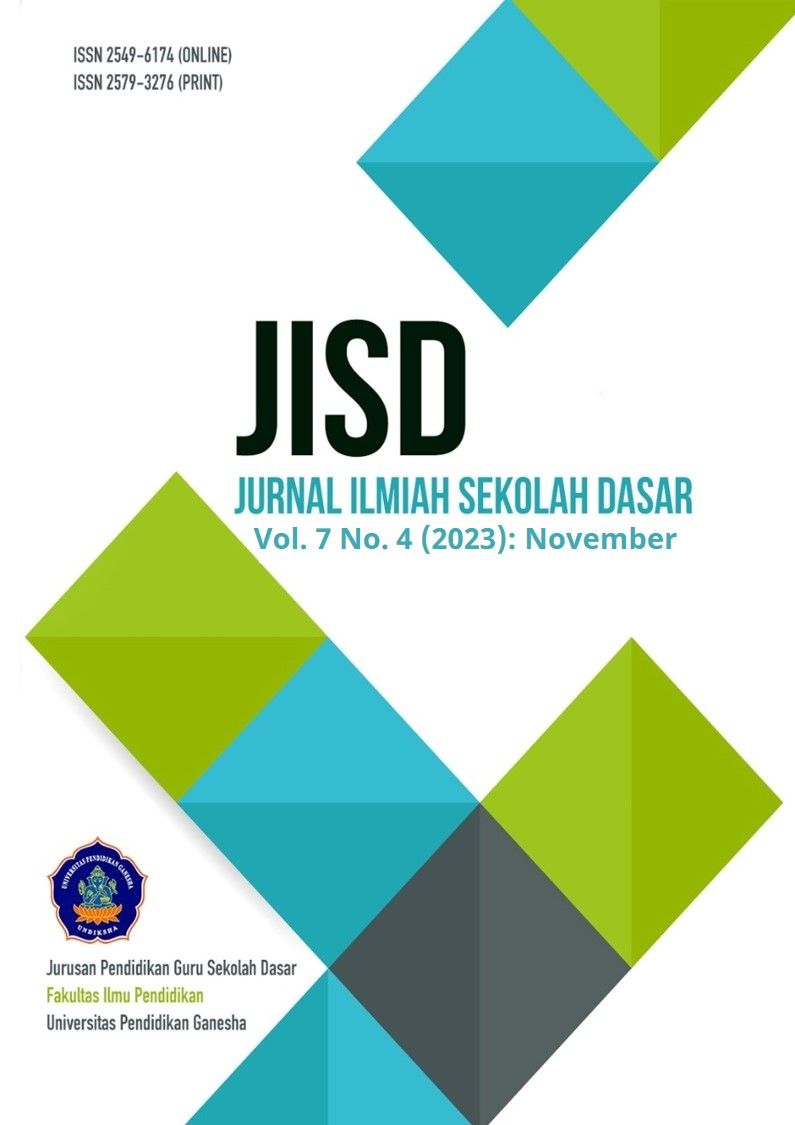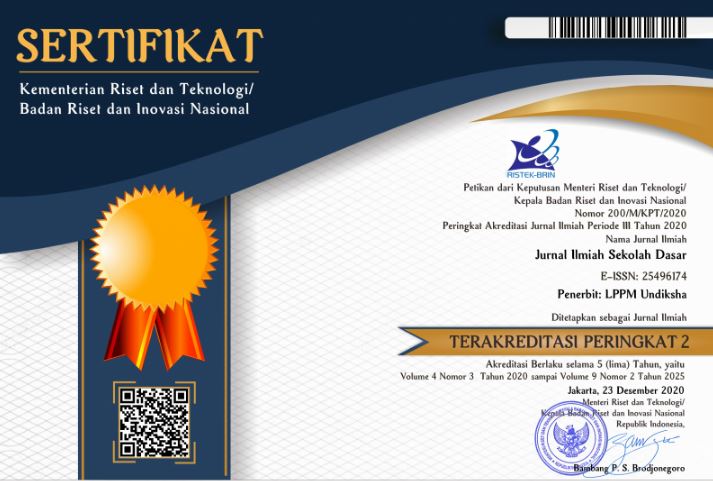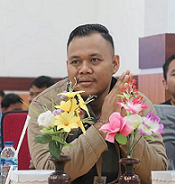Two Stay Two Stray (TSTS) Assisted by Mind Mapping Media on Social Science Learning Outcomes
DOI:
https://doi.org/10.23887/jisd.v7i4.60697Keywords:
TSTS, Mind Mapping, Learning outcmesAbstract
Elementary social studies learning is still dominated by the role of the teacher as a material provider. This causes student involvement in social studies learning to be less than optimal. This research aims to analyze the Two Stay Two Stray (TSTS) learning model assisted by mind mapping media on the social studies results of class V students. This research is a quasi-experimental type with a nonequivalent post-test-only control group design. The sample was determined using simple random sampling with a lottery technique. The research sample consisted of Class V. The data collection method was the test method. The data analysis technique in this research uses descriptive statistical analysis techniques and data analysis prerequisite tests. Hypothesis testing uses the polled variance t-test. The results of calculating the average social studies learning outcomes for experimental group students are very high, while students in the control group are in the medium category. Based on calculations using the t-test, there is a significant influence of the Two Stay Two Stray (TSTS) learning model assisted by mind mapping media on class V students' social studies learning outcomes. Therefore, the TSTS learning model assisted by mind mapping media is suitable for improving students' social studies learning outcomes. This research implies that teachers can think more creatively and gain new insights and experiences regarding implementing innovative learning in the classroom, which is useful for developing students' critical thinking patterns.
References
Adnan, F., Prasetyo, B., & Nuriman, N. (2017). Usability testing analysis on the Bana game as education game design references on junior high school. Jurnal Pendidikan IPA Indonesia, 6(1), 88–94. https://doi.org/10.15294/jpii.v6i1.9597. DOI: https://doi.org/10.15294/jpii.v6i1.9597
Agung, G. (2014). Metodelogi Penelitian Pendidikan. Aditya Media Publishing.
Apriakanti, D., Kusuma, M., & Nurhayati, M. (2020). The effectiveness of two stay two stray (TSTS) cooperative learning model in improving students’ critical thinking skills. Journal of Science Education Research, 4(1), 40–43. https://doi.org/10.21831/jser.v4i1.34240. DOI: https://doi.org/10.21831/jser.v4i1.34240
Arianto, H., & Fauziyah, H. N. (2020). Students’ Response To the Implementation of Case Based Learning (CBL) Based Hots in Junior High School. INSECTA: Integrative Science Education and Teaching Activity Journal, 1(1), 45. https://doi.org/10.21154/insecta.v1i1.2058. DOI: https://doi.org/10.21154/insecta.v1i1.2058
Arsana, I. K., Suarjana, M., & Arini, N. W. (2019). Pengaruh Penggunaan Mind Mapping berbantuan Alat Peraga Tangga Garis Bilangan terhadap Hasil Belajar Matematika. International Journal of Elementary Education, 3(2), 99–107. https://doi.org/10.23887/ijee.v3i2.18511. DOI: https://doi.org/10.23887/ijee.v3i2.18511
Arthaningsih, N. K. J., & Diputra, K. S. (2019). Pengaruh Model Pembelajaran Kooperatif Tipe Two Stay Two Stray melalui Lesson Study terhadap Hasil Belajar Matematika. Journal of Education Technology, 2(4), 128–136. https://doi.org/10.23887/jet.v2i4.16424.
Bystrova, T., & Larionova, V. (2015). Use of Virtual Mind Mapping to Effectively Organise the Project Activities of Students at the University. Procedia-Social and Behavioral Sciences, 214. https://doi.org/https://doi.org/10.1016/j.sbspro.2015.11.724. DOI: https://doi.org/10.1016/j.sbspro.2015.11.724
Dharsana, G. S., & Sidabutar. (2018). Pengaruh Model Pembelajaran Kooperatif Tipe Two Stay Two Stray melalui Lesson Study terhadap Hasil Belajar IPA. MIMBAR PGSD Undiksha, 6(2). https://doi.org/10.23887/jjpgsd.v6i2.19463. DOI: https://doi.org/10.23887/jet.v2i4.16424
Ekayani, N. P. S., Suarjana, I. M., & Jayanta, I. N. L. (2020). Two Stay Two Stray (TSTS) Learning Model Assisted with Mind Mapping Improving Students’ Social Studies Learning Outcomes. International Journal of Elementary Education, 4(3), 337–345. https://doi.org/10.23887/ijee.v4i3.25786. DOI: https://doi.org/10.23887/ijee.v4i3.25786
Farid, A., & Sudarma, I. K. (2022). Meningkatkan Minat dan Hasil Belajar Kelompok Melalui LKPD Berbasis Cooperative Learning Tipe Two Stay Two Stray. Jurnal Edutech Undiksha, 10(1). https://doi.org/10.23887/jeu.v10i1.42138.
Fauzi, A. R., Zainuddin, Z., & Atok, R. Al. (2017). Penguatan Karakter Rasa Ingin Tahu dan Peduli Sosial melalui Discovery Learning. Jurnal Teori Dan Praksis Pembelajaran IPS, 2(2), 79–88. https://doi.org/10.17977/um022v2i22017p079. DOI: https://doi.org/10.17977/um022v2i22017p079
Febiyanti, D., Wibawa, I. M. C., & Arini, N. W. (2020). Model Pembelajaran Kooperatif Tipe Jigsaw Berbantuan Mind Mapping Berpengaruh terhadap Keterampilan Berbicara. Mimbar Ilmu, 25(2), 282–294. https://doi.org/10.23887/mi.v25i2.26620. DOI: https://doi.org/10.23887/mi.v25i2.26620
Handayani, N. (2018). Efektivitas Model Pembelajaran Two Stay Two Stray (TSTS) Ditinjau Dari Hasil Belajar Siswa Kelas V SD Pada Mata Pelajaran Matematika. International Journal of Elementary Education, 2(1). https://doi.org/10.23887/ijee.v2i1.13904. DOI: https://doi.org/10.23887/ijee.v2i1.13904
Hukunala, A., Lesnussa, A., & Ritiauw, S. P. (2021). Penerapan Model Pembelajaran Kontekstual Dalam Peningkatan Hasil Belajar Siswa Pada Mata Pelajaran IPS. Jurnal Pendidikan Sekolah Dasar, 1(2), 62–70. https://journal.actual-insight.com/index.php/sistem-among/article/view/480. DOI: https://doi.org/10.56393/sistemamong.v1i2.480
Hutama, F. S. (2016). Pengembangan Bahan Ajar IPS Berbasis Nilai Budaya Using untuk Siswa Sekolah Dasar. JPI (Jurnal Pendidikan Indonesia), 5(2), 113–124. https://doi.org/10.23887/jpi-undiksha.v5i2.8359. DOI: https://doi.org/10.23887/jpi-undiksha.v5i2.8359
Ismayani, R. M., & Fauziya, D. S. (2019). Pelatihan Kurikulum 2013 di Tingkat Sekolah Dasar. Jurnal Pengabdian Kepada Masyarakat (Abdimas), 02(01), 11–16. DOI: https://doi.org/10.22460/as.v2i1p11-16.2324
Juniantari, I. G. A. S., & Kusmariyatni, N. N. (2019). Pengaruh Model Pembelajaran Kooperatif Two Stay Two Stray Berbantuan Mind Mapping terhadap Hasil Belajar IPA. Jurnal Ilmiah Sekolah Dasar, 3(3), 370–377. https://doi.org/10.23887/jisd.v3i3.19478. DOI: https://doi.org/10.23887/jisd.v3i3.19478
Kistyawati, N., & Amien, M. (2020). Pengaruh Regrouping Dan Motivasi Belajar Terhadap Prestasi Belajar Ilmu Pengetahuan Sosial Siswa Kelas Iv, V Dan VI Sekolah. Elementary School: (Jurnal Pendidikan Dan Pembelajaran Ke-SD-An), 1(2), 953. https://doi.org/10.31316/esjurnal.v1i2.797.
Kurniawan, B., Purnomo, A., & . I. (2020). Penggunaan Aplikasi Google Classroom Sebagai Upaya Peningkatan Pembelajaran Online Bagi Guru Matapelajaran IPS. International Journal of Community Service, 4(1), 1–9. https://doi.org/10.23887/ijcsl.v4i1.22236. DOI: https://doi.org/10.23887/ijcsl.v4i1.22236
Lan, Y. J., Sung, Y. T., Cheng, C. C., & Chang, K. E. (2015). Computer-supported cooperative prewriting for enhancing young EFL learners’ writing performance. Language, Learning and Technology, 19(2), 134–155.
Leniati, B., & Indarini, E. (2021). Meta Analisis Komparasi Keefektifan Model Pembelajaran Kooperatif Tipe Jigsaw Dan Tsts ( Two Stay Two Stray ) Terhadap Kemampuan Berpikir Kritis Pada Pembelajaran Matematika Siswa Sekolah Dasar. Mimbar Ilmu, 26(1), 149–157. https://doi.org/10.23887/mi.v26i1.33359. DOI: https://doi.org/10.23887/mi.v26i1.33359
Lubis, A. B., Miaz, Y., Taufina, & Desyandri. (2019). Pengaruh Model Everyone Is A Teacher Here Terhadap Aktivitas Dan Hasil Belajar IPS Siswa SD. Jurnal Basicedu, 3(2), 725 – 735. https://doi.org/10.31004/basicedu.v3i2.61. DOI: https://doi.org/10.31004/basicedu.v3i2.61
Maulidia, A., & Hanifah, U. (2020). Peran Edukasi Orang Tua terhadap PHBS AUD selama Masa Pandemi Covid-19. Musamus Journal of Primary Education, 3(1), 35–44. https://doi.org/10.35724/musjpe.v3i1.3078. DOI: https://doi.org/10.35724/musjpe.v3i1.3078
Mulyantini, N. L. D., Suranata, K., & Margunayasa, I. G. (2019). Pengaruh Model Pembelajaran Two Stay Two Stray Terhadap Minat Belajar Ipa Siswa Kelas IV SD. Mimbar PGSD, 7(1). https://doi.org/10.23887/jjpgsd.v7i1.17023.
Nilayuniarti, N. P., & Putra, D. K. N. S. (2020). Meningkatkan Kompetensi Pengetahuan IPS melalui Model Pembelajaran Discovery Learning Berbasis Tri Hita Karana. Mimbar PGSD Undiksha, 8(3), 445–456. https://doi.org/10.23887/jjpgsd.v8i3.26043.
Rahayu, M., Sudarma, I. K., & Dibia, I. K. (2020). Enhancement of Science Learning Outcomes through Two Stay Two Stray Learning Model Assisted with Mind Mapping Media. Journal of Education Technology, 4(3). https://doi.org/10.23887/jet.v4i3.25688. DOI: https://doi.org/10.23887/jet.v4i3.25688
Ruhama, I. A., & Erwin, E. (2021). Pengaruh Penerapan Model Pembelajaran Mind Mapping terhadap Hasil Belajar IPA Siswa Sekolah Dasar di Masa Pandemi Covid-19. Jurnal Basicedu, 5(5), 3841–3849. https://doi.org/10.31004/basicedu.v5i5.1422. DOI: https://doi.org/10.31004/basicedu.v5i5.1422
Saraswatha, I. M. D., Japa, I. G. N., & Wibawa, I. M. C. (2016). Penerapan Model PBL untuk Meningkatkan Minat dan Hasil Belajar IPS pada Siswa Kelas IV. Mimbar PGSD Undiksha, 4(1). https://doi.org/10.23887/jjpgsd.v4i1.7015.
Siska, Y., Yufiarti, Y., & Japar, M. (2021). Nilai Pendidikan Karakter Dalam Pembelajaran Ips Di Sekolah Dasar. Journal Of Elementary School Education (JOuESE), 1(1), 1–11. https://doi.org/10.52657/jouese.v1i1.1324. DOI: https://doi.org/10.52657/jouese.v1i1.1324
Sugiyono. (2011). Metode penelitian kuntitatif kualitatif dan R&D. Alfabeta.
Sukmanasa, E., Windiyani, T., & Novita, L. (2017). Pengembangan Media Pembelajaran Komik Digital Pada Mata Pelajaran Ilmu Pengetahuan Sosial Bagi Siswa Kelas V Sekolah Dasar Di Kota Bogor. Jurnal Pendidikan Sekolah Dasar, 3(2), 171–185. https://doi.org/10.30870/jpsd.v3i2.2138. DOI: https://doi.org/10.30870/jpsd.v3i2.2138
Sulistyanti, L., Siahaan, J., & Junaidi, E. (2019). Pengaruh Model Pembelajaran Two Stay Two Stray (TSTS) Dipadukan dengan Metode Demonstrasi Terhadap Hasil Belajar Kimia. Chemistry Education Practice, 2(1), 17–24. https://doi.org/10.29303/cep.v2i1.1137. DOI: https://doi.org/10.29303/cep.v2i1.1137
Sunbanu, H. F., Mawardi, M., & Wardani, K. W. (2019). Peningkatan Keterampilan Kolaborasi Siswa Menggunakan Model Pembelajaran Kooperatif Two Stay Two Stray Di Sekolah Dasar. Jurnal Basicedu, 3(4), 2037–2041. https://doi.org/10.31004/basicedu.v3i4.260. DOI: https://doi.org/10.31004/basicedu.v3i4.260
Susanto, R., & Anti, M. (2017). Pengaruh Model Cooperative Learning Tipe Teams Games Tournament (Tgt) Terhadap Kecerdasan Interpersonal Pada Mata Pelajaran Ips. Jurnal Ilmiah Sekolah Dasar, 1(4), 260. https://doi.org/10.23887/jisd.v1i4.12510. DOI: https://doi.org/10.23887/jisd.v1i4.12510
Syafari, Y., & Montessori, M. (2020). Analisis Pembelajaran Daring Terhadap Motivasi Belajar Dan Prestasi Belajar Siswa Dimasa Pandemi Covid-19. Jurnal Basicedu, 5(3), 1295–1303. https://doi.org/10.31004/basicedu.v5i3.872. DOI: https://doi.org/10.31004/basicedu.v5i3.872
Tanto, O. D., Hapidin, H., & Supena, A. (2019). Penanaman Karakter Anak Usia Dini dalam Kesenian Tradisional Tatah Sungging. Jurnal Obsesi : Jurnal Pendidikan Anak Usia Dini, 3(2), 337–345. https://doi.org/10.31004/obsesi.v3i2.192. DOI: https://doi.org/10.31004/obsesi.v3i2.192
Trisnadewi, N. K., Putra, M., & Ardana, I. K. (2020). Model Advance Organizer Berbantuan Media Grafis Berpengaruh Terhadap Kompetensi Pengetahuan IPS. Mimbar Ilmu Undiksha, 25(2), 1–12. https://doi.org/10.23887/mi.v25i2.25152. DOI: https://doi.org/10.23887/mi.v25i2.25152
Downloads
Published
How to Cite
Issue
Section
License
Copyright (c) 2023 I Kadek Sandika Wirayasa

This work is licensed under a Creative Commons Attribution-ShareAlike 4.0 International License.
Authors who publish with the Journal Ilmiah Sekolah Dasar agree to the following terms:
- Authors retain copyright and grant the journal the right of first publication with the work simultaneously licensed under a Creative Commons Attribution License (CC BY-SA 4.0) that allows others to share the work with an acknowledgment of the work's authorship and initial publication in this journal.
- Authors are able to enter into separate, additional contractual arrangements for the non-exclusive distribution of the journal's published version of the work (e.g., post it to an institutional repository or publish it in a book), with an acknowledgment of its initial publication in this journal.
- Authors are permitted and encouraged to post their work online (e.g., in institutional repositories or on their website) prior to and during the submission process, as it can lead to productive exchanges, as well as earlier and greater citation of published work. (See The Effect of Open Access)










